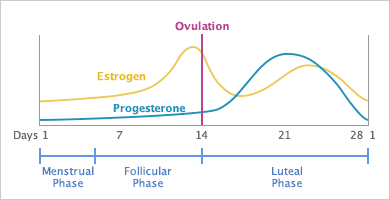Hormonal Impacts on Mental Health - Part 1
Hormones. They weave an intricate dance throughout the body contributing to an array of functions and even influencing mental health. When we think of hormones, we commonly think of sex hormones such as estrogen and progesterone in women, and testosterone in men. Sex hormones are just a small piece of the larger puzzle of hormones, but remain significant in the context of mental health. Part 1 of this article will shed light on how the female sex hormones estrogen and progesterone contribute to mental health and conditions such as anxiety and depression. Part 2 will dive into additional hormonal factors.
Sure we’ve all heard of PMS and the emotional lability that comes along with it, but there’s a difference between a little bit of moodiness and debilitating anxiety and depression. First of all, we shouldn’t have to put up with either. And second of all, we don’t have to, as both situations are treatable. It comes down to a balance between the levels of estrogen and progesterone. Below is a diagram of how these hormones fluctuate throughout a typical menstrual cycle.
Anxiety and depression are often interrelated and can occur on any scale when progesterone is LOW in relation to estrogen. As shown above, approximately one week before menses we see a decline in both estrogen and progesterone. Remember, it’s the balance between these two hormones that is important. Progesterone has a protective effect on mood, and when there is not enough progesterone compared to estrogen we start to see symptoms arise that can range from nervousness, trouble concentrating, and low mood to full on panic attacks and depression.
What is progesterone doing to calm the mind?
Well, it’s not what progesterone is doing but what it’s metabolite (allopregnanolone, or 3α5α-tetra-hydro-progesterone, or simply THP) is doing (1). THP forms when progesterone is broken down in the body. It then activates receptors for the neurotransmitter GABA. GABA is a major inhibitory neurotransmitter in the brain meaning it acts as a “downer” to prevent feelings of anxiety. It is through this telephone-like game that progesterone (through THP, through GABA) functions to calm the mind.
In cases of deficient progesterone and THP, we see an increase in anxiety symptoms. Animal studies continually demonstrate the anxiolytic activity of THP. One study showed that by blocking the breakdown of progesterone into THP, there is an increase in anxious behaviours (2). More relevant in humans is what happens to estrogen and progesterone during fluctuations in the menstrual cycle, perimenopause, and certain conditions such as PCOS.
Estrogen Dominance:
Imbalances between estrogen and progesterone throughout the normal menstrual cycle can result in a state of ‘estrogen dominance.’ This is particularly relevant during the luteal phase or second half of the menstrual cycle, when we see both estrogen and progesterone rise and fall prior to menses. If progesterone levels decline at a faster rate than estrogen, this gives rise to a relative ‘estrogen dominance’ and can result in anxious feelings.
PMDD (premenstrual dysphoric disorder):
When the intensity of mood symptoms prior to menses reaches a point that it is debilitating and seriously affecting quality of life, a diagnosis of PMDD may be made. An increase in negative mood symptoms typically occurs in the late luteal phase, 3-4 days after the peak in serum levels of progesterone and THP. Withdrawal from progesterone at this time and therefore THP is likely contributing to these negative mood symptoms (3).
Perimenopause:
Years before menopause is when we start to see a shift in estrogen and progesterone levels. Prior to menopause during the peri-menopause phase there is actually an increase in estrogen levels compared to progesterone. Low levels of progesterone in relation to estrogen result in feelings of irritability, tension, and other symptoms of general anxiety. By balancing progesterone levels in relation to estrogen using pharmaceutical progesterone, these feelings may decrease.
PCOS (polycystic ovarian syndrome):
This is a condition involving estrogen dominance and other hormonal imbalances including high androgen levels and blood sugar dysregulation. Along with the classic symptoms of acne and facial hair growth, is an increased risk of anxiety and depression (4). Because PCOS affects fertility, this may be a factor in the high rates of depression. However, increased estrogen activity in PCOS (5) is likely also contributing to anxious feelings since there is this disconnect between perceived estrogen and progesterone levels in the body.
What can be done to rebalance estrogen and progesterone?
1. Reducing exogenous estrogen exposure: nowadays we see more and more ‘estrogen dominance’, which may be due in part to the increase in endocrine disrupting chemicals found in our surrounding environment. Among the 1000 chemicals that have the ability to disrupt hormone activity, is the commonly talked about Bisphenol A (BPA). BPA is found in plastics and maintains estrogenic activity, meaning it acts similarly to estrogen in the body (6). BPA and other estrogenic chemicals, also known as xenoestrogens, may be manipulating the relationship between estrogen and progesterone in the body.
2. Herbal medicine: different botanicals can have a powerful effect on hormone balance. Vitex agnus-castus is one such herb that maintains progesterone-like activity. An RCT study, the gold standard of research, showed that after 3 months of therapy Vitex had the ability to eliminate deficits in progesterone during the luteal phase of the menstrual cycle (7).
Many other naturopathic therapies exist to rebalance estrogen and progesterone levels based on an individual's needs. Naturopathic medicine emphasizes patient-centred individualized care requiring appropriate investigations into your WHY, or underlying cause of concerns. Before starting any hormone rebalancing therapies, talk to a health care practitioner to determine what’s best for you.
If you’re interested in learning more about how your hormones may be affecting your mental wellness and what options are available, consider booking a naturopathic consultation.
References:


